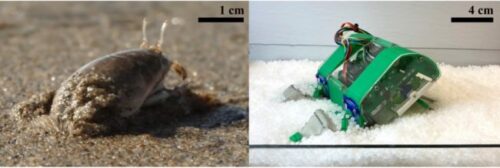Researchers from the University of California, Berkeley have invented a unique robot inspired by a burrowing mole crab that could self-burrow vertically

The process of mole crabs burrowing sand at beaches looks very easy but it is very difficult to move downward through granular media, like sand and soil, as deeper you go digging more force needs to be applied to push the grains back. Therefore, Hannah Stuart, assistant professor of mechanical engineering, and her team have developed special first-legged robots that can self-burrow vertically. This digging robot is named EMBUR (EMerita BUrrowing Robot) which implements a unique leg design to attain downward motion similar to the way Pacific mole crabs bury themselves in beach sand.
Treers, the study’s lead author and a Ph.D. student in mechanical engineering in Stuart’s Embodied Dexterity research group said “There have been some recent advances in creating anisotropic legs for granular media, but this is the first time they have been implemented successfully on a free-burrowing robot,”. EMBUR may enhance our scientific understanding of other burrowing animals, which are difficult to observe and study underground. “Robophysical models, or robotic prototypes like EMBUR, can be tools to help biologists better understand the biomechanics of these animals,” said Treers.
The researchers fabricated a vertical-legged burrower and designed the legs of the robot with an anisotropic force response, which means that they experience a much greater force in one direction than another. The soft fabric legs of this robot expand for large forces during the power stroke but fold and retract during the return stroke similar to the swimmer. The researchers also had to include a way to prevent sand grains from entering the robot’s mechanisms and jamming them, even though this inclusion is inspired by the Pacific mole crab.
She continued “We created a cuticle, which is analogous to the arthrodial membrane found on the mole crab sits a soft, flexible material that lines the openings of joints to prevent grains from getting inside but still allows free movement.” “We used a modeling technique known as Resistive Force Theory [RFT] to model the forces experienced by the legs throughout their sweeping trajectories,” said Treers. “RFT helped us understand the kinds of robot geometries and behaviors that would allow for the most successful burrowing.”
“We plan to improve the design to allow for deeper digging and exploring better modeling methods, like DEM [Discrete Element Methods], to help predict the robot behavior,” said Treers. “Eventually, I’d love to have this robot be able to dig in real beach settings, like the animal, and switch between running, swimming, and digging.”
This research could have a wide range of applications such as gauging the soil quality of potential agricultural sites, geotechnical engineering, marine data collection, and construction and excavation. They could also serve as small deployable anchors from marine vehicles or space rovers, to enable tethered teamwork between robots.
Click for the Published Research Paper and Demo Video








